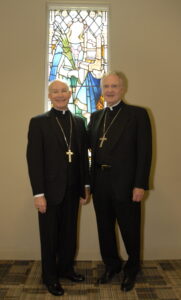
News
Vatican II shaped the Church – and the priesthood of Archbishop Curtiss
May 31, 2023
Recently, Archbishop Emeritus Elden Francis Curtiss celebrated 65 years as a priest. Read more about his priestly vocation here.
The implementation of the Second Vatican Council has been intertwined through 65 years of priesthood for Archbishop Emeritus Elden Francis Curtiss.
He was ordained in the Diocese of Baker, Oregon, on May 24, 1958, four years before the start of the council, as “certain issues and theological developments were starting to ferment,” Archbishop Curtiss said.
He served as a parish priest during and immediately after Vatican II, and in the early 1970s, helped form seminarians first as a teacher then president-rector at Mount Angel Seminary in Oregon.
At age 38, he became the first diocesan priest to lead the Benedictine seminary.
Six years later, Pope St. Paul VI appointed him bishop of the Diocese of Helena, Montana.
Archbishop Curtiss, who will soon be 91, never met the saint who elevated him to the episcopacy, but he did get audiences and photos with every pope since.

Archbishop Curtiss meets with Pope Saint John Paul II.
He said Pope St. John Paul II helped interpret Vatican II and gave it direction.
The Polish pope helped “us get our bearings again. I’m glad I’ve lived long enough to see it pulling together and a lot of the abuses corrected that were done after the council.”
“We’re lucky in this archdiocese because there wasn’t much of a struggle here,” Archbishop Curtiss said. “When I came here, I was amazed at the solidarity of the priests and their support for the archbishop.”
They clearly respected and loved his predecessor, the late Archbishop Daniel E. Sheehan, he said. “He kind of kept things together after the council.”
“I was glad to see that because when I went to Helena, they had a bishop who had been at the council, and he was moving the agenda. There was a lot of confusion in Helena when I got there.”
“When I got here (in 1993),” Archbishop Curtiss said, “I was really impressed with the sense of solidarity, the sense of unity. The priests got along. There weren’t camps. There weren’t divisions.
“There were a few socially conscious priests who kind of pushed the agenda on some things, but it was minor. The priests were together as a whole. There was a harmony here that was good.”
The archdiocese and the Church in general continue to adjust to Vatican II changes.
“It takes a hundred years, you know, for a council to be fully implemented,” the archbishop said.
Still, the archdiocese has had less division than many dioceses. “I think it was because of Archbishop Sheehan and the spirit of the priests,” Archbishop Curtiss said. “I think he had a lot to do with it.
“And I really have appreciated the way Archbishop Lucas picked up after me and continued the process. You know, he’s been wonderful as an ordinary. I was blessed with Archbishop Sheehan on one end and Archbishop Lucas on the other. That’s made it easy for me to be between two great bishops. I think that was part of the peace and cohesion that I felt here that I hadn’t experienced in Helena or in Oregon when I left there.
“You know, this is really a very good, strong archdiocese.”
Mostly, that peace and unity continue here, Archbishop Curtiss said.
“We’ve got progressives, and we’ve got conservatives, but there’s a harmony here. We are one of the most amazing dioceses right now in the country as far as keeping the agenda going and the people involved for the most part. We’re blessed. This is a blessed diocese. It really is.”

Archbishop George J. Lucas is pictured with Archbishop Emeritus Elden Francis Curtiss.